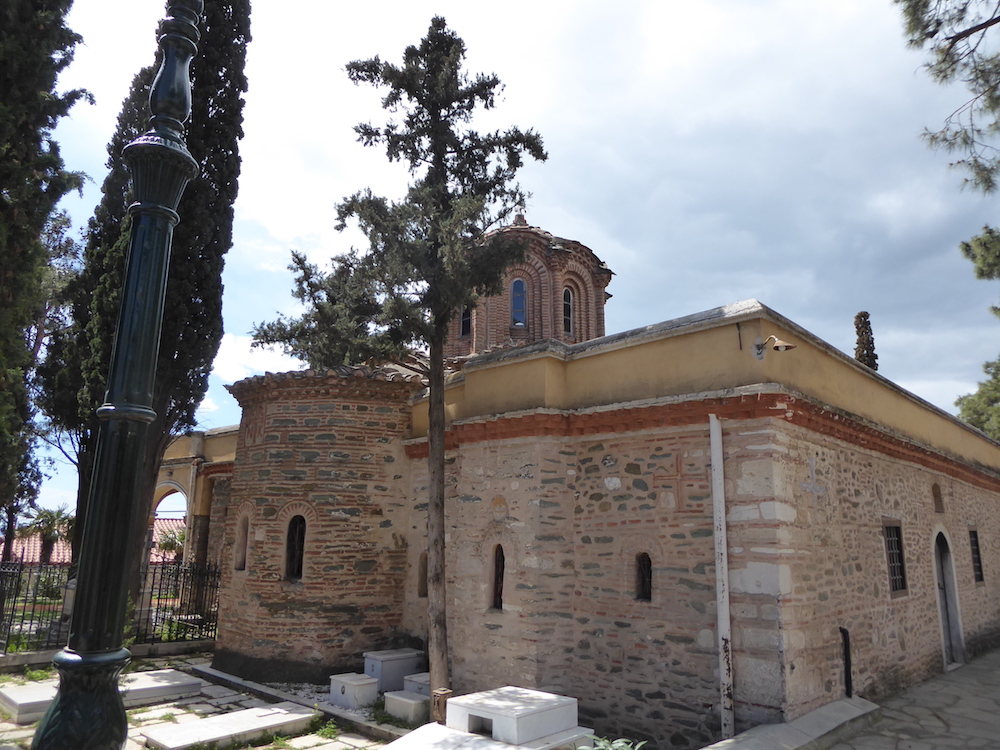Thessaloniki looks impressive from the old city walls in the hills of Ano Poli. Beyond, the bay shimmers in the sunshine and the distant mountains are capped with snow.
But the city is not quite as neat and tidy close up. Our walk from the centre to the upper town revealed evidence of decay, economic deprivation and Thessaloniki’s struggle with the notorious Greek financial crisis, as well as centuries of history.
Like any city, Thessaloniki has parts that are best avoided and much to be proud of. It also has a market. Modiano, built in the 1920s, was quiet on a Sunday morning when we walked through with just a few stallholders doing business inside a building that has certainly seen better days. Indeed, netting and mesh across the façade suggested it needed some urgent attention to stop it crumbling into the pavements. Next door is the Kapani Market, making the area a maze of food, drink and practical household goods. As we wandered by, restaurant and cafe staff were setting up for the lunchtime rush.

The market is one of the many 20th century buildings that make up modern Thessaloniki. Much of the old city was destroyed by the great fire of 1917 and the earthquakes that have rattled the windows of Greece on frequent occasions. But there are older survivors, not least the Roman remains and a collection of sturdy Byzantine churches. Many of the latter date back centuries and betray their age by the fact that they’re now well below the modern ground level. Some have gone from churches to mosques and back again depending on the ruling clique; some are grand and pompous, others modest and charming. The Church of Panagia Acheropoietos has been rebuilt many times on the site of an old Roman baths but its oldest structures are 5th century. The Church of Panagia Halkeon must sit on old Roman remains too as it’s by the old forum, which would’ve been the heart of the Roman city.

These days the excavated Forum, surrounded by a modern Greek city square, gives some idea of how important it must’ve been to the locals but much has been lost. The Palace of Galerius (which we’d visited the day before) is a short walk away and is a similar pile of excavated ruins. It’s nigh on impossible to picture how grand this building would’ve been when Emperor Galerius was entertaining the locals back in the 4th century but it’s just possible to make out the footprint of the building and the scale of the Octagonal Room, an imposing, high-ceilinged structure that could’ve been a throne room and certainly had impressive mosaics. The information boards were comprehensive and in several languages.
The back streets on the climb up to Ano Poli were not as impressive. Scarred with mindless graffiti, car-filled streets, empty shopfronts and pollution, they weren’t exactly inviting. The Turkish Consulate was surrouned by barbed wire and security, testament to the tense relations between Greece and Turkey. There’s a museum there commemorating the founder of modern Turkey – Ataturk – but I didn’t fancy getting through all that security to see it. So we panted and sweated our way uphill through the increasingly narrow streets, over potholes, via desperate dereliction until we met the walls at the top. And all that panting was well worth it because the views were fantastic.

The walls were built in the 4th century and were many miles long back then, but there’s relatively little left today. We passed through a gate and had coffee in a local café, served by an old man with the most extraordinary sunken cheeks, before climbing up the circular Tower Of Trigoniou to get the best of the views. Then we tried to follow a walk back down to the sea described in our Lonely Planet guide, but soon got lost in the maze-like streets and alleys – this is a part of town that mostly escaped the 1917 fire and the rebuilding of the city on a new grid system. We eventually found the Monastery of Vlatadon, a haven away from the busy street with all that the nuns would need to sustain them – from sheep to a tiny and ancient chapel. Beyond the monastery were dilapidated cottages and graffiti, churches and flights of steps, battered cars and rubbish. It was typically Greek.
Back towards the town centre we stopped for a pleasant lunch and explored the Roman remains. The circular Rotunda is the star, built by Emperor Galerius in the early 4th century and now part of the UNESCO World Heritage Site. It was probably meant to be the great ruler’s mausoleum but it later became a temple, Christian church and a mosque, when a minaret was built in the grounds. Inside are some marvellous, colourful frescoes.

A short walk downhill is the Arch of Galerius, part of the Emperor’s grand design for the heart of the city, linking the Rotunda with his palace. Today the remains of the arch, which was built at the end of the 3rd century to mark Galerius’s victory over the Sassanid Persians at the Battle of Satala, are stuck beside a noisy and unpleasant main road but there are some fine sculpted panels that depict the ruler’s victories and his family on its pillars.
We walked on through the city centre, finishing our walk at Ladadika for some much-needed beer. In the evening the bars of Thessaloniki were throbbing again, which isn’t that usual for a city on a Sunday night, but all those students who make up such a huge proportion of the population need somewhere to quench their thirst. We joined them. And very nice it was too…


